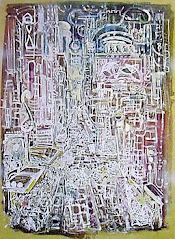What’s the Difference Between ‘Abstract’ & ‘Stylised’ painting?
There are countless art styles worldwide, each bringing unique and eye-catching work to life. Art styles can evoke several emotions, from Art Deco prints to detailed portraits. With numerous established art styles, they can be hard to differentiate. In this blog post, we discuss abstract and stylised paintings, the key elements of each style, and how they differ.What Are Abstract Paintings?
We stock a vast range of abstract art prints, one of our favourite visual styles. Abstract art came from a place of change. As society grew, so too did the desire for new art. In turn, this unique art style was highly conceptual, no longer focusing on replicating scenes from the real world or creating recognisable motifs. This new style used shape, colour, and line to create striking imagery. The style departs from the real world, creating imagery that does not resemble reality. Abstract art can sit at different levels of familiarity. Some paintings are extremely obvious in what ideas they represent. Others are less easily understood and can evoke thought and emotion in a viewer. Abstract art can help us see the world from a new perspective, comparable to cubism or surrealism. The earliest works of abstract art are geometric and linear. These works have appeared in several mediums, including pottery, fabrics, and rocks. Many believe that abstract shapes and symbols represent ideas; however, they are still easily admired without understanding the meaning.
Abstract art allows us to create meaning and choose how we interpret a work of art. The critical difference with abstract art is that the aim is not to create an object or reflection of reality but to create feeling and emotion.
One of our favourites, Broadway (1936) by Mark Tobey, is made up of white lines on top of a dark blue and red canvas. The white lines are nothing more than squares and shapes, but they work to create an abstract cityscape. The piece immediately evokes the feel of a loud, bright, bustling city street. There is not a single building, taxi, or storefront painted.
They both give artists the power to sway from reality and focus on creating unique works that use the technique to tell a story. Abstract art leaves much more to the viewer’s interpretation, with no ties to realism. Stylised artwork incorporates unique, stylistic elements from the artist. The subject is recognisable, but the artist has more freedom to experiment and put their unique twist on reality.
Abstract, on the other hand, eliminates the reality aspect. Artists have the freedom to combine visual elements to produce awe-inspiring artwork. Colours and shapes are combined to create striking imagery. You don’t need to understand what is happening in the piece to admire abstract art—all you need is a pair of eyes. The art will evoke an emotional reaction.
NZ Fine Prints offers an extensive range of art prints from artists worldwide. From famous abstract paintings to stylised Kiwiana imagery, we have the perfect wall art for your home. Explore our full range of art prints online today.
 |
| Broadway by Mark Tobey |
However, with only a smattering of white lines, our brains can make sense of the painting and recognise the abstract elements of a city, further encouraged by the busy feeling of the artwork.
Stylised paintings use more recognisable imagery to create bold and unique art pieces. The art becomes ‘stylised’ by using colour and shape distortion to disconnect the image from reality. Stylised art allows artists more freedom to experiment with shapes and colours to create beautiful imagery. Stylised art aims to depict a subject effectively but with a unique style that takes away from realism.
Stylised paintings sit as a stepping stone, sitting between realism and abstract. There is a clear representation of an object but no need for accuracy. Instead, there is the freedom to be creative and paint beautiful, bold pieces.
Some stylised works are exaggerated and focus on the essential details to emphasise and exaggerate the overall look of the painting. Other stylised artworks are more minimal, aiming to portray an object accurately but with as little detail as possible.
What Are Stylised Paintings?
Our Milford Sound vintage travel poster is an excellent example of a beautiful, stylised painting. The
piece includes an obvious depiction of a mountain—the famous Mitre Peak—made of blue, red, and yellow tones. The colour pallet creates the subject clearly, but with hardly any fine detail, just colour mixed beautifully to create a stylised interpretation.
piece includes an obvious depiction of a mountain—the famous Mitre Peak—made of blue, red, and yellow tones. The colour pallet creates the subject clearly, but with hardly any fine detail, just colour mixed beautifully to create a stylised interpretation.

No comments:
Post a Comment